Answer these simple questions and we will find you the BEST prices
Which type of solar quotes do you need?
It only takes 30 seconds
100% free with no obligation

Tell us what you need to find a matching specialist

Get free quotes from professionals near you

Compare offers and choose the one that best matches your need
- whatcost.co.uk
- Home Insulation
- Best Insulation Types
What Are the Best Insulation Types? A UK Guide

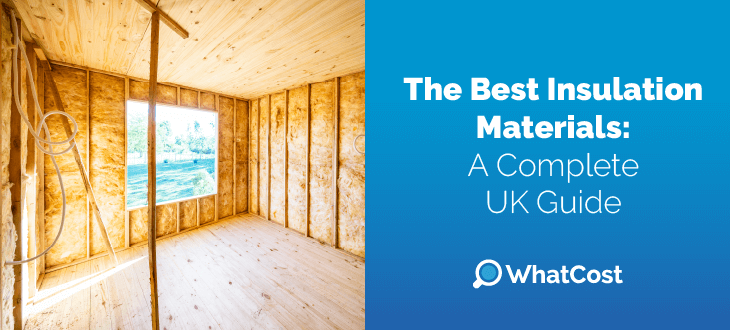
- Choosing the best insulation material for your home relies on factors such as your budget, home type, insulation application and much more.
- A combination of wall, loft, and floor insulation measures can cut your home heat loss by a remarkable 67%.
- Insulating your walls, floor, and loft can save you £630 - £730 on annual energy bills.
Insulating your home is a key component of any energy-efficient upgrade. It helps to keep your home temperature regulated, providing warmth in the winter and cooling in the summer. Acoustic insulation can also help to reduce noise pollution, ideal for homes in dense urban areas.
Various types of insulation are available on the market, each with advantages and disadvantages. However, picking the best fit for your budget and needs can require some work. That's why this complete guide by WhatCost will walk you through all you need to know about the different types of insulation available, including pros, and cons and how to decide on what is best for you.
Time to insulate your home? Let WhatCost set you right! By spending just 30 seconds filling out our online survey, you can receive up to 3 free home-tailored quotes directly from our nationwide network of pre-vetted professionals. No costs or obligations apply. Simply click below to begin!
What is the best insulation for homes in the UK?
The best insulation types hinges on several important factors, such as the insulation project at hand, your budget, and other personal preferences. Nevertheless, here are some top contending materials on the market that are popular amongst customers:
- Fibreglass: A sustainable material made from recycled glass spun into sheets and blankets. Fibreglass is affordable, easy to install, and good for most applications, boasting excellent flame, moisture and mould resistance.
- Mineral wool: Mineral wool is made from rock or glass products that are spun into sheets and blankets. The material is popular due to its budget-friendliness and installation versatility. Similar to fibreglass, mineral wool has to be handled with protection as it can cause eye, skin and respiratory irritation if mishandled.
- Spray foam: A polyurethane (PU) based expanding foam that boasts a superior insulation value, and air-sealing properties, but can be unsustainable, expensive to install and even more expensive to remove, especially if in lofts. Spray foam is best when tailored to very specific insulation jobs, such as underfloors.
- Polystyrene: Found in the form of rigid boards, as well as beads for cavity wall fill, polystyrene is cost-effective, lightweight, and has good moisture resistance. It may have a lower insulation value than some of its counterparts, but it makes up for its durability against moisture and weathering.
When choosing the best thermal insulation, you will need to account for heat resistance and whether the type meets your needs. As a rule of thumb, more thermally efficient materials will cost more per m2. The best bet is to consult with a professional installer who can conduct a home insulation check and tailor the best course of action for your needs.
Best insulation for walls
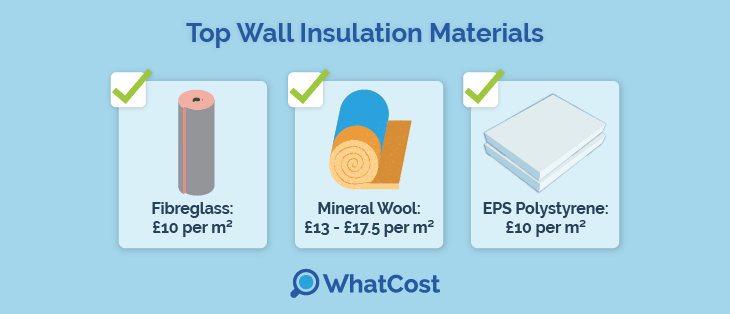
Insulating walls is a highly effective way to reduce energy consumption and lower heating bills. By insulating your walls, you can significantly reduce heat loss, potentially saving up to £370 per year for a detached home with cavity walls and up to £500 for a home with solid walls.
The type of insulation material you choose will depend on whether your home has solid or cavity walls, but some materials are compatible with both. Here’s a breakdown of the best options:
Fibreglass
Made from recycled glass materials that have been woven into a blanket-like sheet, fibreglass is one of the most popular materials for all forms of wall insulation - cavity wall, internal wall, and external wall - and for good reason!
It’s sustainable, flame and smoke-resistant, and budget-friendly at only £10 per m2. The semi-porous nature of fibreglass also allows for vapour to evaporate, helping to regulate moisture. The key downside of fibreglass is that it is highly irritating to the skin, eyes and respiratory system, meaning it must be handled with protective gear.
Mineral wool
Similar to fibreglass, but more thermally efficient, mineral wool is made of processed glass or rock that can be woven into blanket-like sheets, or denser insulation boards. Costing around £13 - £17.5 per m2, mineral wool boasts impressive qualities like flame and mould resistance, while also demonstrating an impressive heat retention.
Mineral wool is also highly versatile, making it suitable for wall cavity insulation, as well as internal and external wall insulation projects. Like fibreglass, it must be handled with protective gear to avoid skin, eye or respiratory irritation.
EPS polystyrene
A newcomer to the market, EPS polystyrene can be found as beads, a favourite for cavity wall insulation, or as rigid boards. Costing around £10 per m2, this material is highly durable for weathering, moisture, and mould, making it a great choice for long-term comfort.
As a downside, EPS polystyrene is less sustainable than its blanket counterparts, but in turn much more durable and long-lasting. While it takes more energy and resources to produce EPs polystyrene, the material can be broken down and processed into new products.
Best insulation for lofts
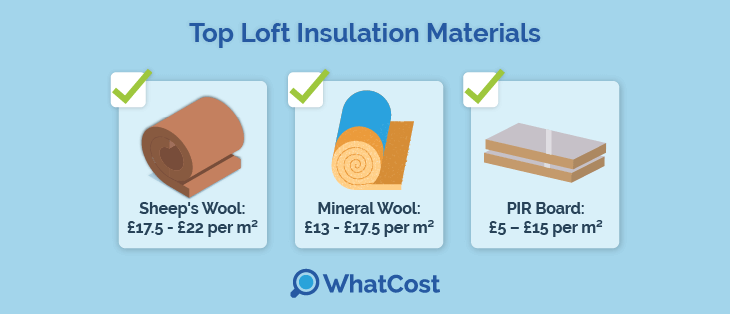
Loft insulation is a crucial step in improving a home's energy efficiency. Uninsulated lofts can account for up to a quarter of home heat loss, driving up energy bills and reducing comfort. To maximise your energy savings, homeowners should consider various loft insulation options. Let’s have a look at the best loft insulation UK:
Sheep's wool
One of the most natural and hypoallergenic materials on the market today, sheep's wool is taken from farm excesses during the shearing season and treated for durability. This material is then compressed into sheets, perfect for loft floor and roof rafter insulation.
However, sheep's wool comes with a higher price tag of £17.5 - £22 per m2 due to its seasonal collection, as well as impressive heat-retaining capabilities.
Mineral wool
Due to its lower cost of £13 - £17.5 per m2, and unmatched versatility, mineral wool makes for a great insulator even for loft spaces. The sheets can be conveniently cut to fit floor joists and roof rafters, as well as easily wrapped around awkward shapes and hard-to-reach crevices.
As mentioned, mineral wool can cause mild to severe irritation if in direct contact with skin, eyes or respiratory system. This is why it's recommended to work with a professional installer.
PIR board
Made from a polyisocyanurate synthetic polymer, these rigid insulation boards are highly durable and exceptionally heat transfer-resistant. Costing around £5 – £15 per m2 depending on the material density,
Most impressively, PIR boards boast a u-value of 0.022 - 0.028 W/m²K, making them one of the most effective heat insulators on the market today. A downside is that polyisocyanurate is a synthetic material that is energy-consuming to produce, and very difficult to recycle or dispose of.
Best insulation for roofs
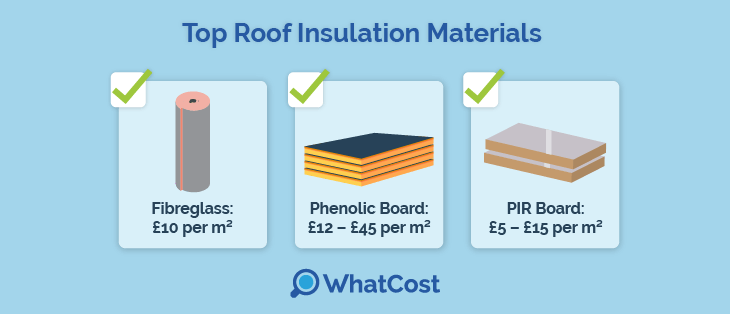
While not all lofts are habitable, insulating your roof remains a worthwhile investment. It offers the same advantages as standard loft insulation, such as improved energy efficiency, reduced heating costs, and lower carbon emissions. Certain types of insulation material are specifically designed to be the best loft insulation between rafters, let’s have a look at them:
Fibreglass
As one of the most affordable and versatile materials on the market, fibreglass makes for a great roof insulator, especially from the inside in between the roof rafters. Its decent heat retention capabilities and resistance to flame, smoke, moisture and mould make it a reliable option to work with if you are on a budget.
However, fibreglass does have a comparably lower insulation capability, as exemplified by its lower cost. This means that you’ll require 270mm or more of insulation thickness to achieve similar heat retention to around 100mm of PIR board or other efficient materials.
Phenolic board
One of the reigning champions of heat retention, phenolic boards boast an unmatched efficiency, as seen by their remarkable u-value of 0.018 W/m²K. A phenolic board is a rigid type of insulating with a 95% or more closed-cell structure, making it nearly impervious to moisture.
As a downside, this material is by far one of the most expensive price ranges on the market, at around £12 – £45 per m2. While the overall investment is much higher, so is the capacity for heat retention.
PIR board
Rigid PIR boards make a great roof rafter insulation material due to their durability and impressive heat retention capabilities. Their rigidity can also help strengthen the structural integrity of a pitched roof. PIR boards are also great solutions for flat roof insulation, whether internal or external.
The only downside is that PIR is not a malleable material, like mineral wool or fibreglass. This means it’s not easy to insulate crevices and awkward shapes, only flat surfaces.
Best insulation for floors
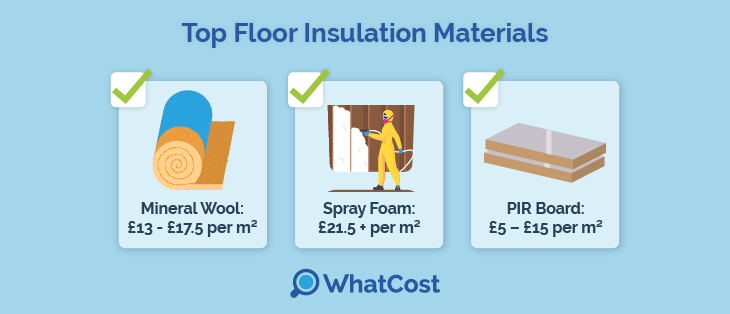
Uninsulated floors can account for a significant portion of heat loss in your home, often around 8%. By investing in proper floor insulation, you can significantly reduce energy consumption and lower your heating bills.
There are two primary types of floors: solid and suspended. Solid concrete floors are common in modern homes, while older houses often feature suspended timber floors.
Mineral wool
Mineral wool is back on our list due to its remarkable versatility, making it one of the best underfloor insulation materials. Sheets of mineral wool can be fitted and secured between floor joists for suspended timber or solid floors under concrete slabs or above with a layer of screed.
As a downside, mineral wool is not as moisture-resistant as some other alternatives. This could be a headache for solid concrete floors, as damaged insulation will require tearing up the floor to remove.
Spray foam
Polyurethane (PU) spray foam exhibits one of the most impressive heat retention properties, with an u-value of around 0.022 - 0.028 W/m²K. In addition, it's practically moisture-impervious and very sturdy. While its difficulty to remove is a serious problem for loft insulation, it’s much less of an issue for floor insulation.
As a downside, spray foam costs around £21.5 + per m2. In addition, it is highly unsustainable, difficult to replace, and cannot be recycled or disposed of safely.
PIR board
Rigid insulation boards - especially PIR - boast rigidness, durability, and remarkable heat retention, making for perfect floor insulation, whether solid or suspended timber. Sheets can be cut to fit in between floor joists, or laid directly over concrete floors and covered in screed.
As a small downside, PIR insulation boards are very sturdy, and cannot bend around awkward shapes, or fit comfortably into tight crevices. It’s usually recommended to pair rigid insulation with other draughtproofing measures for an optimal finish, which can cost more.
Best insulation for sound
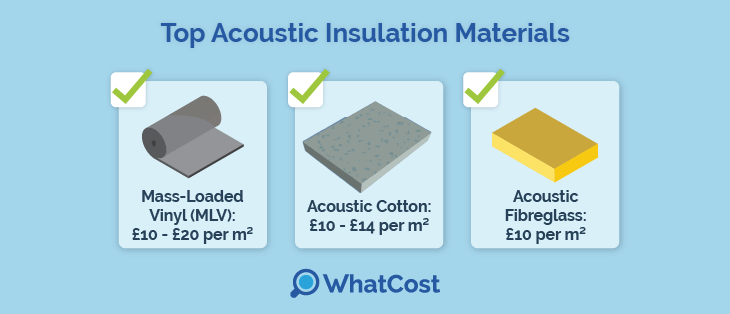
The main distinction between acoustic and thermal insulation lies in their density. Acoustic insulation, designed to block noise, is typically much denser, successfully creating a barrier that can absorb or even reflect sound waves entirely.
While thermal insulation excels at regulating temperature, its lighter weight often limits its soundproofing capabilities. Conversely, acoustic insulation may not always provide optimal thermal performance, depending on its specific composition.
Here are some of the top-performing acoustic insulation materials on the market today:
Mass-loaded vinyl (MLV)
Mass-loaded vinyl (MLV) is a highly dense and thin vinyl sheet that boasts remarkable sound insulation capabilities. Due to its concentrated density, MLV can easily reflect sound waves. It costs around £10 - £20 per m2 and can even be installed as a DIY project.
As a downside, MLV is a synthetic material that requires lots of energy to produce and is not very easy to recycle or discard.
Acoustic cotton
Dense acoustic cotton is one of the most effective soundproofing materials available today. At a density of around 55 kg/m³, it provides impressive noise-cancellation performance while also being entirely natural and recyclable.
Acoustic cotton costs around £10 - £14 per m2, and can be found as boards, sheets or batts. It’s important to note that acoustic cotton does not provide sufficient thermal insulation.
Acoustic fibreglass
Acoustic fibreglass is similar to normal fibreglass, just much denser. Costing around £10 per m2, it’s made from recycled glass products that are woven into a blanket-like structure.
While it may provide a small degree of thermal insulation, acoustic fibreglass is optimised to reduce sound transfer, not heat transfer. Therefore, it’s good to know that acoustic fibreglass cannot double as effective heat insulation.
How do you decide on the best insulation type?
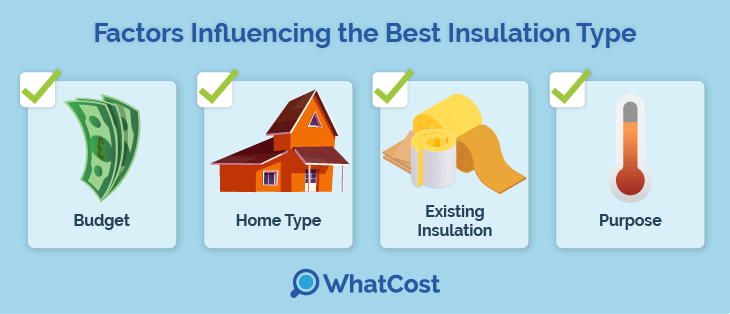
With all the options on the market, deciding on the best insulation type for your home may seem a little daunting. The truth is, that each home will have its own best fit, depending on factors like your budget, home type, installation complexity and other specific needs.
To help refine your choices, follow these key pointers to efficiently choose your best insulation material options:
- Budget: Your budget for a home insulation cost will influence your material choice. Affordable options like mineral wool or fibreglass offer good performance, while premium choices like PIR boards and spray foam provide superior insulation at a higher price range.
- Home type: Your home's construction will determine suitable insulation types. Cavity walls, for example, require cavity wall suitable insulation, while flat roofs benefit from PIR boards or rigid foam.
- Existing insulation: If your home already has effective insulation, topping it up can be a cost-effective solution. Assess the condition of your current insulation to determine the best course of action.
- Purpose: Clarify your goals. Thermal insulation focuses on temperature control, while acoustic insulation reduces noise. Consider your priorities in selecting the right materials.
Make sure to invest in professional installation. A certified installer will ensure proper workmanship, optimal performance, and long-lasting results that bring your home comfort for decades. Sadly, most prospective customers find themselves stuck in an endless loop of researching and vetting with no bargain in sight. Luckily, WhatCost can solve this for you!
Instead of spending endless hours searching online, spend just 30 seconds filling out our simple online intake form and receive up to 3 free home-tailored quotes from our network of trusted professionals. No costs, no obligations. Click below and find the best bargain for you today!
FAQ
The most effective type of insulation hinges on many factors, such as purpose, home type, budget, and much more. For example, mass-loaded vinyl (MLV) can be considered one of the best acoustic insulators but is terrible at heat retention.
The insulation materials with the highest heat retention capability are phenolic boards and PIR boards. Both are synthetically made and boast remarkable heat resistance and durability, making them a great choice for long-term comfort.
The best insulation material for walls in the UK depends on your needs and preferences. The most popular material is generally mineral wool or fibreglass. This is due to their cheaper price tag and versatility, making them suitable for internal, external, and cavity wall insulation jobs.
The best insulation material for roofs hinges on your roof type, condition, budget and more. The most popular materials are mineral wool or fibreglass due to their relative affordability and versatility. The malleable nature of these soft sheets also means it’s easier to insulate awkward shapes, angles and hard-to-reach roof areas.
The overall cheapest insulation material is multi-foil insulation boards. Made from aluminium layers bonded with foam insulation in between, it costs an affordable £3 – £4 per m2 and provides very little heat retention.

Akif has a keen interest in green home improvement solutions and the role of digital media in identifying climate trends. He aims to provide a multidisciplinary approach to content rooted in credible research and accuracy.
